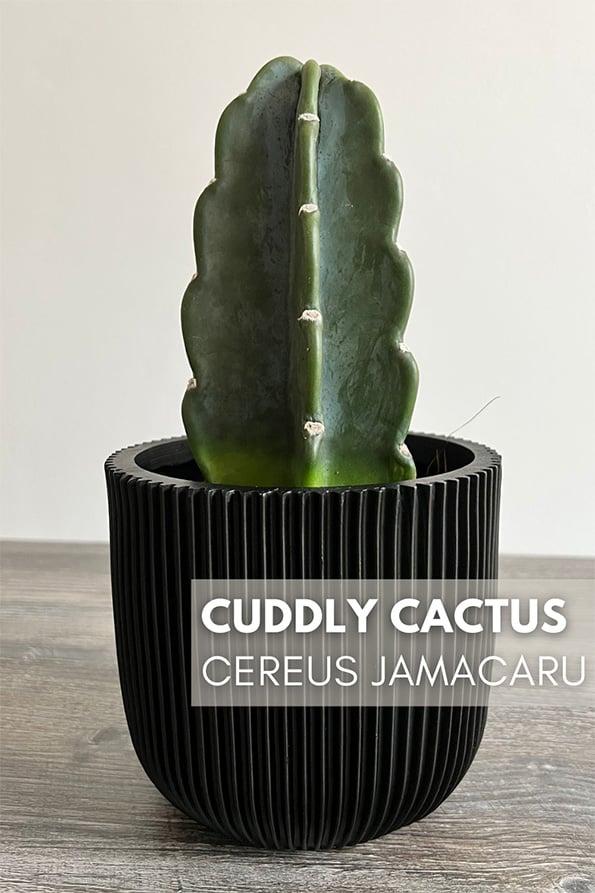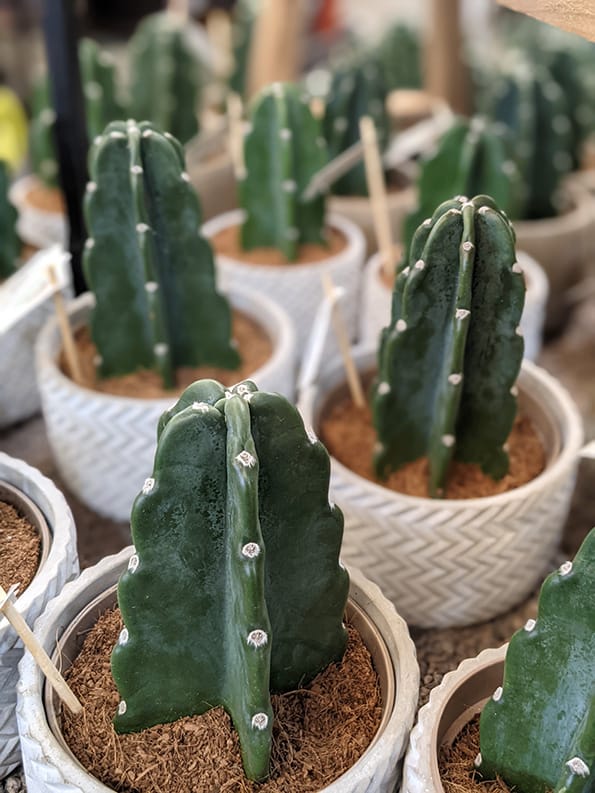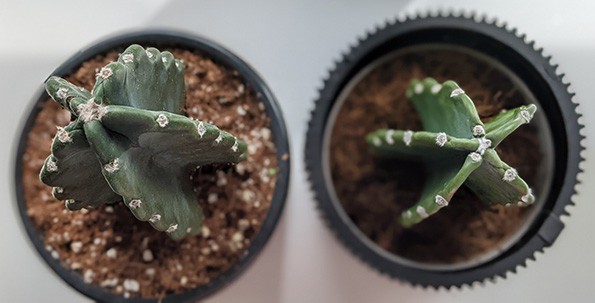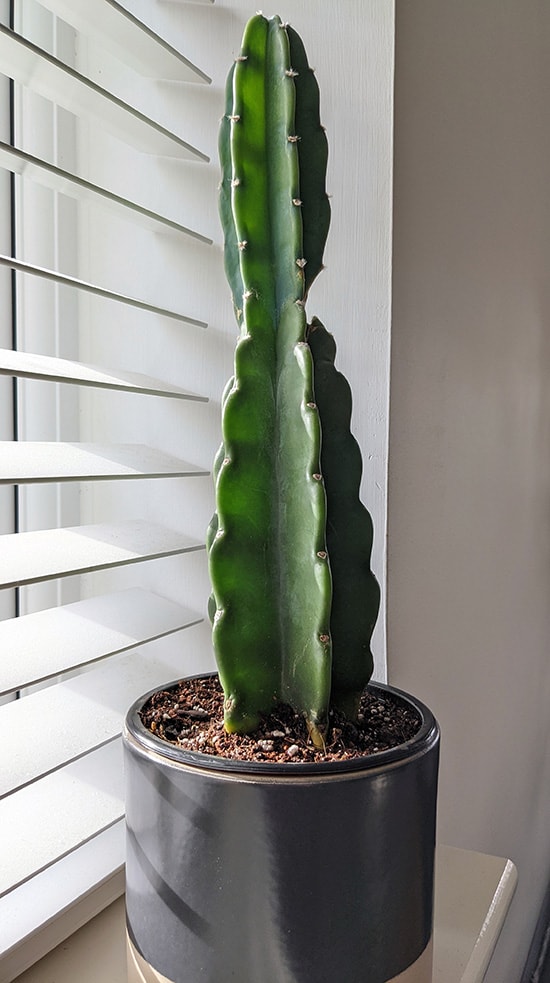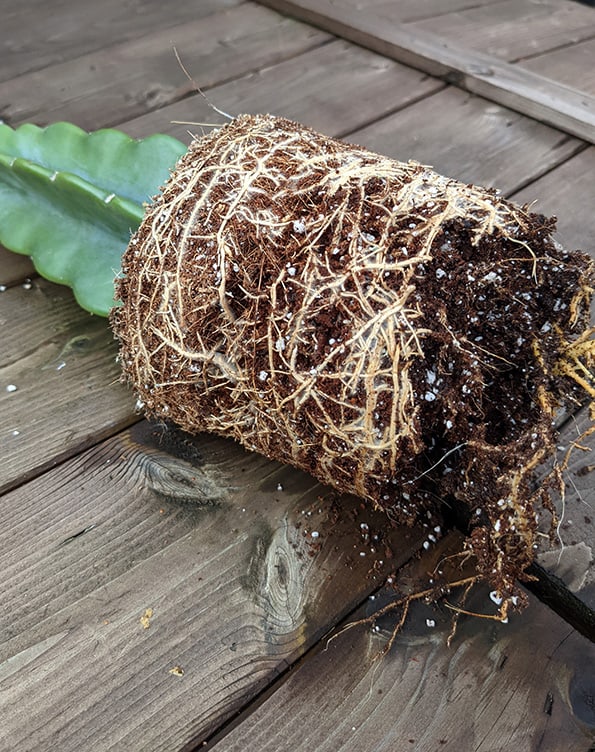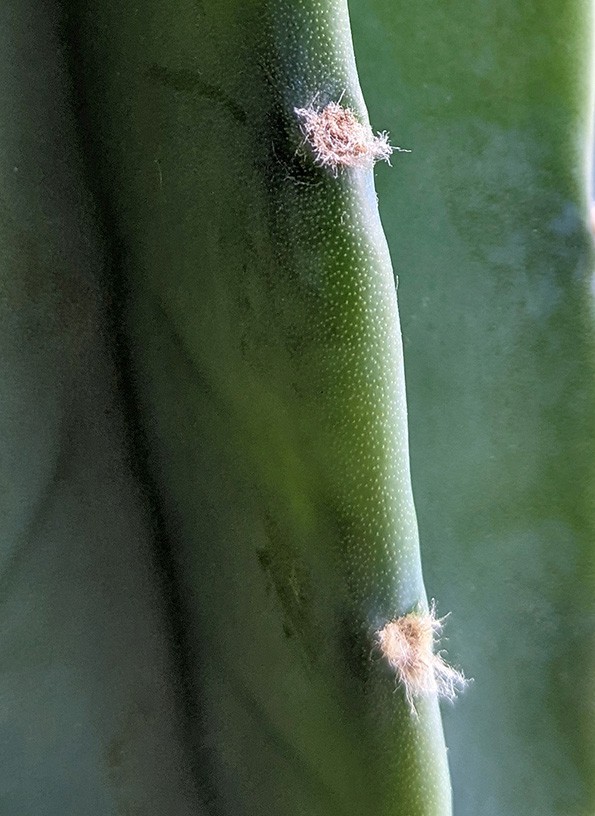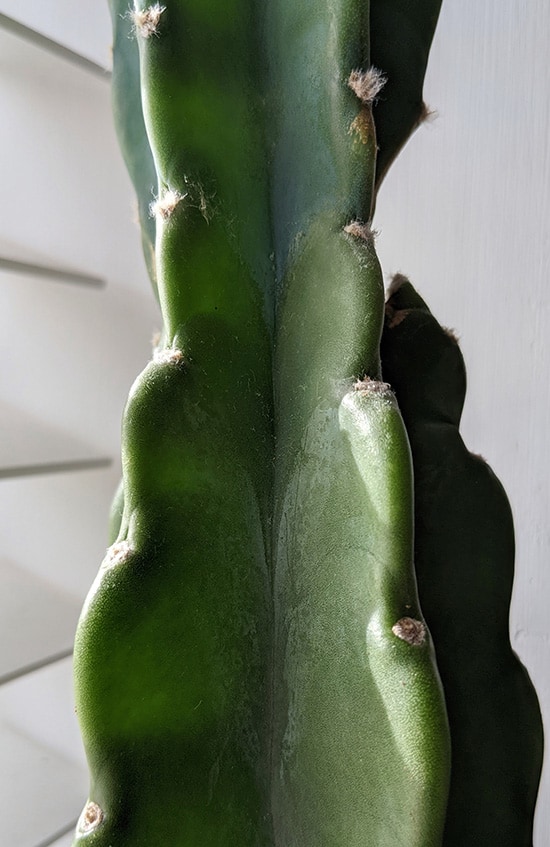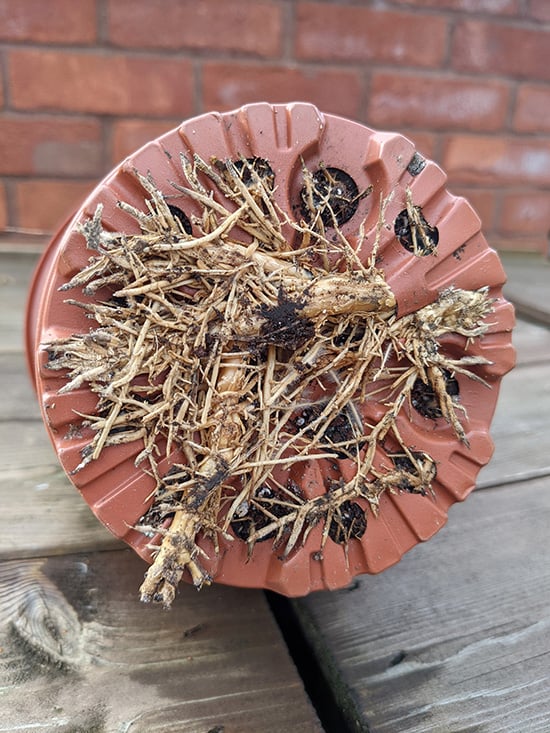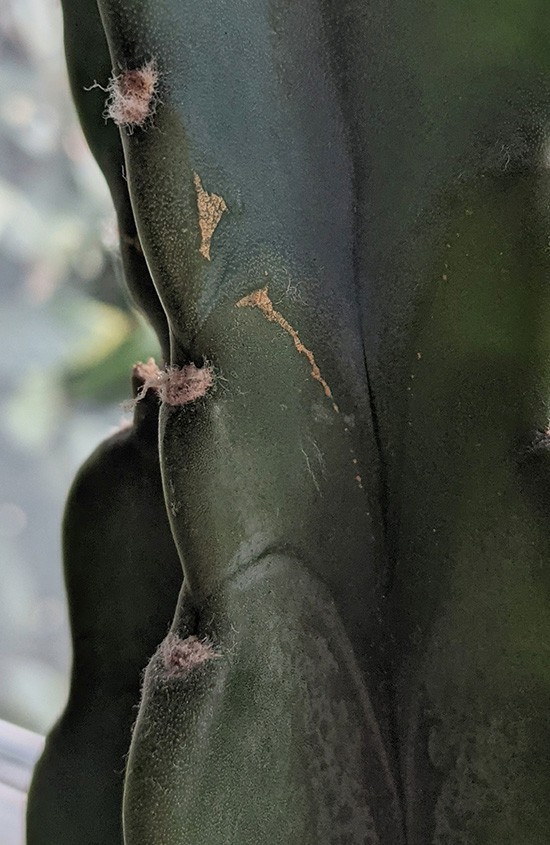Cereus Jamacaru "Cuddly Cactus" is a striking and distinctive species native to South America, particularly Brazil.
Its common name derives from the soft, hair-like fluff where some plants of this species would normally have protective spines / thorns. Unlike almost any other cacti, you can literally give this one a hug if you wanted too.
It's an easy going houseplant as long as it gets ample sunlight, and receives infrequent watering to prevent root rot. It's drought-tolerant and thrives in arid conditions, making it a perfect plant for any suntraps in your home.
The Spineless Cereus Jamacaru (Mandacaru cactus) has been given the marketing name "Cuddly Cactus" because of its lack of spines and chunky, thick look.
Most Cuddly Cactus plants are grown as a single stem, but they can branch with age or if you remove the top section of the plant. The stems often have five distinct ridges (sometimes only four or as many as six) that have scalloped-like waves on the edges.
How do you pronounce Cereus Jamacaru correctly? Say:
Seer-ee-UHS Ja-ma-car-OH
The majority are sold as small plants, and the growers tend to scrape out the fluff at the areoles. This makes them very smooth and supports the "Cuddly Cactus" marketing appeal for these plants.
The plant isn't truly spineless however. Once your plant grows and new areole form, you will see the fluff, but hiding under this are small blunt spines. They're not particularly sharp or dangerous but you can feel them with a finger.
Did You Know?
Some people believe the Cuddly Cactus is a cultivar and was bred on purpose not to produce spines. But actually this plant was found growing natively and so is a natural variety. As well as being used for animal feed, it has become a trendy houseplant in the last few years.
New growth tends to have a bluish sheen, which will usually darken within a year or so. Growth can be very fast for a cactus, putting out 10in / 25cm each year. But it only happens over the growing seasons, usually late Spring and Summer.
There is no doubt they're gimmicky plants. So I do understand why some people might turn their noses up at them or declare them "not a real cactus".
However they do actually belong to the Cactaceae family and they do actually make interesting houseplants to own. The cuddly "thorn-less" aspect also makes them safe plants if you've always been put off by the more familiar cacti with their protective thorns.
The absence of spine clusters and the white fluffy spots along the edges make a unique feature of these plants. I especially love the green vibrant hues on the established plant parts and the blue hues you get on brand new growth.
I've got several of these plants now, and I'm a fan. They're visually attractive and I love how they have a chunky and upright aesthetic that draws the eye.
Cuddly Cactus care is easy too, and coming up next I'll share everything I've learned about these plants over the last few years. I'll then cover some problems you may encounter and how to fix them.

Hi, I'm Tom!
If you're like me and enjoy the challenge of growing houseplants and getting them to thrive, then Ourhouseplants can help. This website shares my knowledge and years of growing plants and provides (hopefully) helpful advice on properly caring for your indoor plant friends.
The Cuddly Cactus is an adaptable plant and will put up with less light than you might think. They should be fine as long as it's a bright spot, although growth may be slower or nonexistent. You could also get some etiolated growth, which some people dislike.
Medium and low light locations are not suitable for these plants, at least not long term.
What they really want to thrive though, is full sun. A few hours a day at a minimum. They'll be happiest in a sunny spot that receives direct sunshine for most of the day.
Cuddle Cacti are thirsty plants if the light levels are high and the temperature is warm. In the height of summer I'm watering almost twice a week. That's just my experience of my own plants from growing them behind glass on a south facing window ledge. It's both hot and very sunny. You could very well need to water it much less.
The key is to water your plant well and then not water it again until the potting mix has thoroughly dried out. How long that takes will determine how frequently they need watering.
Need More Guidance?
I created a quick 4 question quiz for people wondering how often to water their Snake Plant. The Cuddly Cactus has similar watering needs to a Snake Plant, so if you need extra guidance take my quiz.
The exception to this is winter where overwatering can easily trigger root rot. Cut back over this period and let the potting mix stay dry longer than usual.
This is also essential all year round if the place you've chosen for it gets cool daytime temperatures and anything less than full sunlight.
Only watering once or twice a month over winter is going to be plenty. When things get warm in early spring increase the watering again.
Let's talk underwatering quickly. Most houseplants end up being overwatered, but Cacti tend to have a reputation for being extremely drought tolerant (which they are) and are often underwatered as a result.
Because of its ridges, Cereus Jamacaru has a larger surface area and these ridges can shrivel and become thin when the plant is underwatered for an extended period (I'm talking weeks or months of no water here). My photo below demonstrates what can happen.
You can mostly reverse this "damage". Water the plant well and over the next week it should plump back out again.
The Cuddly Cactus on the left has been adequately watered, it's clearly full with water and looks plump and healthy. But the one on the right is extremely underwatered. Note the very thin ridges, shriveling and poor coloring.
They're adapted to arid conditions so any spot in your home will be perfect. They will also be fine in kitchens and bathrooms. However do avoid terrariums and bottle gardens where the humidity levels will be too high.
The Cuddly Cactus is adapted to nutrient poor soils and therefore it doesn't require heavy or frequent feeding. Twice a year using a succulent fertilizer or regular houseplant fertilizer is going to be enough.
Even though it's a spineless cactus variety it still needs as much sun as its spiky counterparts. The Cuddly Cactus can take direct sunlight and dry conditions in their stride. It's like having a touch of the desert in a corner of your home.
These are primarily heat loving plants. So aim to provide temperatures between 65°F to 90°F (18°C to 32°C) for much of the year. However, it can tolerate cooler temperatures down to 41°F (5°C) during the winter months.
They're not frost hardy and freezing temperatures will either finish off your plant or seriously damage it.
I've found that the Cuddly Cactus has a more robust root system compared to most other cacti I've grown. The roots are pretty thick and fibrous with a strong tap root that can deform growing containers.
Additionally the amount of root space directly affects how tall this plant can grow. If the roots are restricted they won't grow at all. I experienced this first hand last year. After several years of decent growth, last year, nothing. Not a single inch grew.
Many Succulents are okay with small pots (I wrote a full article on this topic if you want to learn more). But the payoff is usually no growth above the soil, and this is also true for the Cuddly Cactus.
If you want your plant to grow you must upsize it whenever the roots fill the pot and growth stops. This could be every few years.
Don't cheat by picking a much larger container. Too much root space will drastically increase the chances of root rot due to the potting mix vs root ratio.
This plant has filled it's planter (and some) it desperately needs more space for those roots to grow into.
I use coconut coir and perlite in my mix and I'm very pleased with this and happy to recommend it. However, you also won't go wrong using a well-draining cactus or succulent potting mix.
You can also create your own mix by combining regular potting soil with perlite or coarse sand for better drainage.
Avoid using peat as this holds too much water (as well as being damaging to the planet).
If you'd like to watch me talk about my plant, here's my care guide on YouTube
The average houseplant owner may struggle with Cuddly Cactus propagation as it's unreliable. If you want to give it a go, then a stem cutting approach will give you the greatest chance of making it work.
If you'd like to try, take a stem cutting from a healthy, mature stem using clean, sharp shears. Allow the cutting to callus over for a few days to prevent rotting. Plant the cutting in a well-draining cactus mix and keep the soil lightly moist. Roots should develop between a few weeks to a couple of months.
If you've tried this (or another method) let me know what happened in the comments below.
Top Tip
It may have "cuddly" in the name, but these are tough plants and as hardy as any other cactus. You don't need to baby this plant for good results.
Growth is fast, but it's only temporary. Each year, if the growing conditions and your care are good, the plant will rapidly produce a large amount of growth.
This usually sprouts from the top of the plant and has a lighter green, almost bluish tint. Side shoots or offsets around the base are also possible.
Typically this will all happen at some point from late Spring until the end of Summer. Once it's done growing that will probably be it until next year. This new growth will harden up and the color will change.
This cactus species can grow to impressive heights, reaching up to 30 feet in its natural habitat. Indoors this will be considerably less.
In general this is a fairly "new" houseplant so very few people have owned them long enough to establish their maximum sizes when grown as indoor plants. Watch this space.
My plants have never flowered, but this will be due to immaturity. It often takes many years before these plants will produce blooms.
If they do bloom, expect white or red flowers that are relatively large (up to 25cm / 10in). Although the plant will produce a fair few flowers, they don't last long. Typically a day or two at most.
Cereus Jamacaru plants (sometimes called Mandacaru cacti), are generally considered non-toxic to pets such as cats and dogs.
They also don't have the large thorns and spines that most cactus plants have. However they do still have small blunt thorns. I don't think this will likely cause any damage to pets (or people), but it's worth being aware of.
If you already have this plant you can put your finger on the fury parts on any new growth and you'll feel blunt thorns. They gently scrape and catch on your skin but it's not painful. Most owners will still class this as a pet friendly plant.
V lines on the Plant Stem.
This is caused by the plant growing. When new growth forms, it splits part of the stem to do it. It will heal and fade over time, but it's to be expected to see slight V shapes or color changes at these "new growth" points for years afterward.
These V shaped lines are common with many cactus plants including the Cuddly Cactus.
Soft and Mushy, Rotting.
If your Cuddly Cactus is rotting then it's going to have been caused by overwatering or cold temperatures. If serious rot has set in, then the outlook normally isn't very good. However if it's mild and you suspect overwatering treat them like you would an overwatered succulent.
No Growth.
It's doubtful you'll get growth all year round. This is a stop-start houseplant, so six months or more without growth is considered perfectly normal.
When the roots are coming out the drainage holes like this it's a sure sign your plant is overdue a repot.
If you've not seen any growth for six months or longer, there are a few other causes to consider.
New growth on Cuddly Cactus is thin.
Typically new growth will be thinner to start with, but it should thicken a little over the following few months. However if it stays thin, then it's almost certainly down to insufficient light and has become etiolated.
If you're growing your plant indoors it's reasonably common to experience this on new growth. The plant you've brought has been grown with perfect light levels and this will be difficult to provide at home.
You can either accept this "look" or find a brighter spot for it. Alternatively put it outside during the hot months of the year to give it a boost.
Corking.
"Corking" in cacti refers to the formation of corky tissue or woody areas along the stem. This phenomenon typically occurs as the cactus ages or in response to stress factors such as insufficient light, overwatering, or inadequate drainage.
These brown marks on succulents and cacti are very common and are usually not a cause for alarm.
Damage is also a common cause of corking. Whether it's from being knocked and bruised or accidentally cut. The healing process often causes these brown markings. It is a form of scaring. It can look unsightly but you can't remove it. Think of it as part of the history of your Cuddly Cactus.
